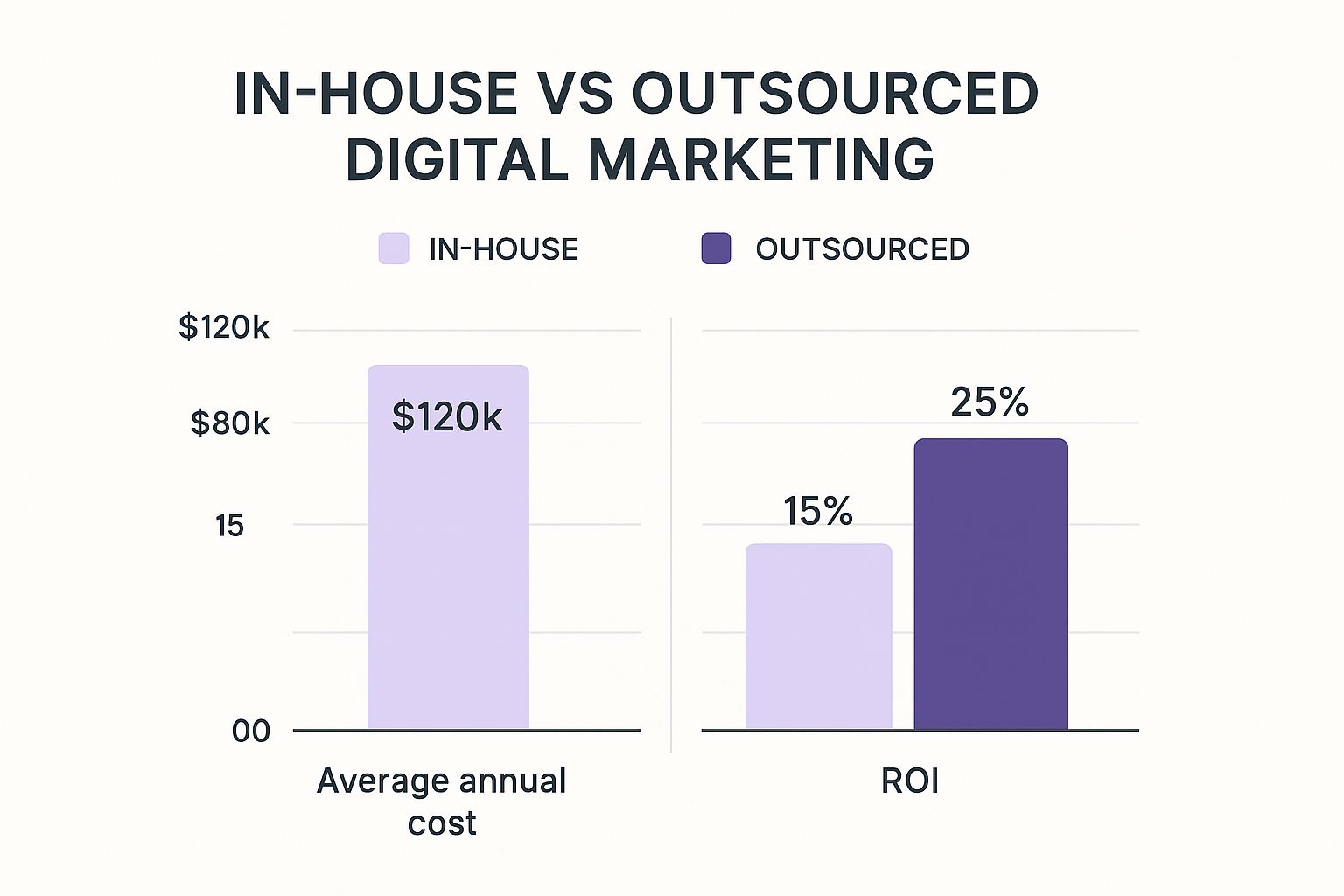
When you hear digital marketing outsourcing, you might picture simply offloading tasks you don’t have time for. But it’s much more than that. It's a strategic decision to hire an external agency, freelancer, or specialized team to manage all or part of your company's online marketing.
Think of it like this: you’re an expert at building an incredible product, but getting the word out online feels like a different language. Instead of spending a fortune to hire, train, and manage a full marketing team from scratch, you can partner with outside experts who already live and breathe this stuff.
At its core, digital marketing outsourcing is about bringing in a specialist pit crew for your business. While you focus on driving the car—running your business—they handle everything else. From tuning the engine (SEO) to managing the fuel (PPC ads), their job is to make sure you perform at your peak.
This isn't just about saving time. It's about gaining immediate access to specialized skills, advanced tools, and proven strategies you likely don't have in-house. An external team comes ready with deep expertise in areas like:
This approach transforms marketing from a fixed overhead cost into a flexible, scalable investment. You can tap into a deep well of talent on demand, precisely when you need it.
This shift toward outsourcing isn’t a small trend; it's a major global business movement. The global outsourcing market is on track to hit around $450 billion by the end of 2025. Companies aren't just doing this to cut costs anymore. They're seeking a competitive edge by accessing specialized skills and making their operations more efficient. You can find more insights about outsourcing trends and their impact on the global market.
By outsourcing, your business can zero in on its core competencies—what you do best—while leaving the complex world of digital promotion to seasoned professionals.
Key Takeaway: Outsourcing digital marketing is less about saving money and more about investing in expertise. It provides immediate access to a skilled team that can generate results faster than an in-house department could be built from scratch.
To give you a better idea of what this looks like in practice, let’s break down the most commonly outsourced digital marketing services.
This table shows the marketing tasks businesses most frequently delegate and highlights why bringing in an expert makes sense for each.
| Service Area | Key Activities | Why Businesses Outsource It |
|---|---|---|
| SEO | Keyword research, on-page optimization, link building, technical audits. | SEO is complex and ever-changing; experts stay on top of algorithm updates. |
| PPC Management | Campaign setup, ad copywriting, bid management, A/B testing. | Requires constant monitoring and optimization to maximize return on ad spend. |
| Content Marketing | Blog writing, video production, case studies, white papers. | High-quality content creation is time-consuming and needs strong writing skills. |
| Social Media | Content scheduling, community engagement, analytics reporting. | Demands consistent daily activity and an understanding of platform-specific trends. |
Ultimately, outsourcing these functions allows you to leverage expert knowledge without the long-term commitment and overhead of hiring, ensuring every part of your digital strategy is handled by a specialist.

While saving money is a nice bonus, the real power of digital marketing outsourcing is strategic. This isn't just about handing off tasks you don't want to do. It’s a calculated move to scale your business and get a leg up on the competition, fundamentally changing marketing from a cost center into a true growth engine.
Think of it like building a championship sports team. You wouldn’t hire one person and expect them to be the star player, head coach, and lead strategist all at once. It's the same in marketing. Expecting a single in-house generalist to master everything from technical SEO to paid media is not only unrealistic—it's inefficient.
Outsourcing immediately plugs you into a full roster of specialists. These aren't just people who dabble; they live and breathe their respective fields, staying on top of every algorithm update, new platform, and emerging best practice. An external partner brings a depth of knowledge that would take you years and a massive budget to build from scratch.
This is especially critical for complex, data-heavy disciplines. One of the biggest wins is gaining access to niche skills that allow for sophisticated PPC campaign optimization, which can dramatically boost your return on investment. Instead of a slow, painful learning curve, you get expert execution from day one.
An outsourced agency or team brings a fresh perspective, challenging internal assumptions and identifying opportunities your team might overlook. This outside view is invaluable for breaking through growth plateaus.
A seasoned agency has probably solved your exact problem for dozens of other clients. They don't have to guess. They bring tested frameworks and proven strategies to the table, cutting down the time and money you’d otherwise waste on trial-and-error marketing.
This direct line to specialized talent translates into faster, bigger results. We’ve seen e-commerce brands, for example, triple their ad ROI in a single quarter by partnering with an agency that has deep performance marketing experience. Trying to get that same result in-house could take years of hiring, training, and subscribing to expensive tools.
The benefits of this accelerated growth compound quickly:
Ultimately, outsourcing your digital marketing is a strategic play. It infuses your business with top-tier talent, drives measurable results, and builds a more agile growth engine—all without the high overhead of a large internal department.
Picking the right digital marketing outsourcing model is a lot like choosing a vehicle for a road trip. A sleek sports car is great for a quick dash, but you'd want a rugged SUV for a long, unpredictable cross-country journey. In the same way, the best outsourcing model for your business comes down to your specific goals, budget, and how hands-on you want to be.
There are really three main routes you can take, and each one comes with its own unique set of benefits. Getting a handle on them is the first step toward finding a partner that will actually fuel your growth, not just check boxes.
Let’s break them down.
Hiring a freelancer is like calling in a specialist for a very specific job. Need a powerhouse series of blog posts or a single, high-impact social media campaign? A freelancer brings that laser-focused expertise and flexibility.
You get deep skill in one area, exactly when you need it.
Bringing on a digital marketing agency is like hiring an entire, fully-coordinated pit crew. You don't just get one person; you get a whole team of experts—strategists, copywriters, SEO specialists, and ad managers—all working in sync under one roof. This model is built for comprehensive, long-term growth.
This is a popular and powerful option for a reason. When you're weighing your choices, understanding the real advantages of working with agency partners can show you how a truly holistic approach drives results. Agencies provide the structure, processes, and accountability that businesses need when they want a hands-off, results-driven solution.
Key Insight: An agency partnership isn’t just about delegating tasks; it's about gaining a strategic partner dedicated to your long-term success. They provide the strategy, execution, and reporting in one complete package.
The image below paints a clear picture of the financial and performance edge that outsourcing offers over trying to build and manage a full in-house team.

As you can see, outsourcing doesn't just cut down annual costs; it often delivers a much higher return on your investment.
To make the choice clearer, here’s a side-by-side look at how these models stack up against each other based on what usually matters most: cost, control, and expertise.
| Model | Best For | Cost Structure | Level of Control |
|---|---|---|---|
| Freelancers | Short-term, specific tasks | Per project or hourly | High control over task, low over strategy |
| Agencies | Comprehensive, long-term strategy | Monthly retainer or performance-based | Low control over day-to-day tasks |
| Managed Teams | Blended control and expertise | Monthly fee per team member | High control over talent and direction |
Ultimately, your decision hinges on balancing these factors. Freelancers offer pinpoint solutions, agencies deliver full-service strategy, and managed teams provide a powerful hybrid of control and dedicated talent.
This brings us to the managed team model, often called staff augmentation. Think of it as the best of both worlds. You get dedicated professionals who work exclusively on your business—just like in-house employees—but you skip all the administrative headaches of recruiting, payroll, and benefits.
This approach blends the dedicated focus of an internal team with the operational ease of outsourcing.
It’s no surprise this is a fast-growing trend. The global IT outsourcing market, which is closely linked to digital functions like analytics and SEO, jumped 13% between 2020 and 2021 alone. Today, IT services account for about 54% of all outsourced operations, highlighting just how much businesses prefer this integrated approach.
This model is quite different from bringing in a traditional consultant. If you want to dig deeper into those distinctions, our guide on staff augmentation vs consulting breaks it all down. It’s the perfect fit for companies that demand direct control over their marketing talent but want a partner like LatHire to handle all the operational heavy lifting.

Deciding to pursue digital marketing outsourcing is a huge step. But to make sure the partnership actually works, you need a clear roadmap. This isn't just about handing over the keys to your marketing; it's about building a structured, collaborative relationship from the ground up.
The whole process starts with a good, hard look in the mirror. Before you even think about finding a partner, you have to define what success looks like for your business. Without clear goals, you can’t measure performance, and your partnership will be aimless.
Success starts with a solid foundation built on clear goals and careful planning. Honestly, this initial phase is the most important part of the entire outsourcing journey.
First, define your Key Performance Indicators (KPIs). Are you trying to get more leads? Drive higher website traffic? Boost sales conversions? These metrics need to be specific, measurable, and agreed upon right from the start. A big part of this is being able to accurately calculate social media ROI to prove you’re getting real business results.
Next, you absolutely must create a detailed project brief or Statement of Work (SOW). Think of this document as your North Star. It should outline everything from the project scope and deliverables to timelines and budgets. A well-written SOW is your best defense against scope creep—that all-too-common problem where project requirements start expanding out of control.
A well-defined SOW doesn't just protect you; it empowers your partner. It gives them the clarity they need to deliver exactly what you expect, eliminating guesswork and aligning both parties toward a common objective.
Once your internal prep is done, it's time to start the search for the right partner. This means doing your homework to find a team with both the skills and the right cultural fit for your business.
Finding the right outsourcing partner is about more than just comparing price tags. You’re looking for a true extension of your team, and that requires digging deep to ensure their capabilities match your goals.
Start by looking at their portfolio and case studies. You want to see proven success with businesses similar to yours, whether in size or industry. Don’t just glance at the pretty final products; analyze the results they claim to have delivered.
Here are a few essential questions to ask any potential partner:
Finally, lock down your communication protocols. Decide how often you'll meet, which channels you'll use (like Slack or email), and who the key points of contact are. Nailing this down early ensures a smooth workflow and prevents misunderstandings, setting your partnership up for success from day one.
Let's move from theory to reality and see how digital marketing outsourcing plays out in the real world. To do that, we’ll walk through a practical example of how a company can build a high-performing team using the managed team model with LatHire.
Imagine a growing e-commerce company based in the U.S. They've got their eyes set on expanding into the Latin American market. The problem? Their in-house marketing team is talented, but they lack the specific expertise needed to make a real impact there. They need fluent, bilingual SEO specialists who genuinely understand local search trends and cultural nuances.
This is a classic skills gap. Trying to fill it with traditional hiring could drag on for months, costing time and money they don't have.
Instead of starting a long, expensive search, the company decides to partner with LatHire. They aren't just handed a list of names; they get a clear, streamlined path to building a dedicated team that feels like their own.
It all starts by defining the core need: two SEO specialists with proven experience in Latin American markets. The company provides a detailed job description to LatHire, which then dives into its extensive talent pool to source and vet qualified candidates.
Within days, not months, the company receives a shortlist of pre-vetted professionals. Every profile is packed with verified skills, a solid work history, and assessment results, allowing them to make a confident choice.
This is the managed team model in its element. The company gains dedicated experts who function as a direct extension of their own department. Meanwhile, LatHire takes care of all the headaches—international payroll, benefits, and legal compliance—freeing the company to focus on what it does best: strategy and execution.
This approach combines the control of an in-house team with the efficiency of outsourcing. The business directs the marketing strategy while LatHire manages the operational backend, creating a seamless and powerful partnership.
The results are tangible and immediate:
This use case shows how outsourcing can be a genuinely smart business move for companies looking to scale effectively. For a deeper dive, you can learn more about why hiring remote workers from LatAm is a smart business move and how it can drive sustainable growth.

For a long time, outsourcing digital marketing was all about one thing: saving money. That era is ending. The conversation has shifted from finding the cheapest labor to building genuine, value-driven partnerships. We're now talking about innovation, quality, and real-world results. It's an evolution that's happening right now, giving smart businesses a serious edge.
A huge part of this shift is thanks to Artificial Intelligence (AI). AI tools are becoming the engine room of outsourced marketing, turbocharging everything from deep data analysis to content creation and customer service. But this isn't about replacing people. It's about empowering them. AI gives outsourced teams the ability to work faster and with more precision, meaning your partners can spot market trends sooner and craft campaigns that hit the mark every single time.
The New Focus: Outsourcing is no longer just a cost-saving tactic. It’s a strategic investment in quality and innovation. The goal has moved from doing things cheaper to doing them better.
This pivot toward quality is changing everything, right down to how businesses budget for and choose their partners. In fact, projections show that by 2025, companies will be spending an average of $115.46 per employee on business process outsourcing. This isn't just a random number; it signals a clear move toward performance-based relationships where results are what count.
This evolution isn’t just strategic—it's geographic. While the classic outsourcing destinations are still in the game, a new wave of talent hubs is emerging and demanding attention. These regions offer that perfect mix of affordability, a highly skilled workforce, and rock-solid infrastructure.
Tapping into these global talent pools is how you build a marketing team that’s both resilient and incredibly effective. If you're ready to explore these options, our guide to the best countries for outsourcing is packed with insights to help you find specialized talent in the world's top destinations. Thinking ahead like this is what will separate the leaders from the laggards in the years to come.
Of course. Here is the rewritten section, crafted to sound completely human-written and natural, following the provided style guide and examples.
Even when you’ve got a solid plan, a few nagging questions about digital marketing outsourcing can pop up. It’s completely normal. Let’s tackle some of the most common ones head-on so you can move forward with confidence.
There’s no magic number here. The cost of outsourcing can swing wildly depending on what you need and who you hire. A small, one-off project with a freelancer might only set you back a few hundred dollars. On the other hand, a full-service agency on a monthly retainer could be anywhere from $3,000 to over $10,000.
But here's a better way to think about it: instead of asking "how much does it cost?", reframe the question to "what ROI do I need?" Your budget should be tied directly to your business goals. A great partner won’t just give you a price list; they’ll help you build a budget that makes sense for the results you're chasing, making sure every dollar you spend comes back with clear, measurable value.
Worrying about a new team capturing your brand’s unique voice is a totally valid concern. The good news is, it’s also completely preventable with a little prep work. The secret lies in creating a rock-solid brand style guide before anyone writes a single word.
Your guide should be the go-to resource for your new team and include things like:
Think of your brand guide as the DNA you pass on to your external team. It gives them the genetic code to replicate your brand’s personality flawlessly across every channel and campaign, ensuring consistency no matter who is creating the content.
Ready to jump in? The best way to start is by looking inward first. Before you even think about talking to an agency or freelancer, get crystal clear on what you want to accomplish. Define your goals and the specific KPIs you'll use to measure success.
Once you know your destination, map out the route. Create a detailed project brief or a Statement of Work (SOW). This document is your north star—it should clearly lay out all the deliverables, timelines, and responsibilities. Only after you’ve done this homework should you start looking for a partner, checking out portfolios, and asking for references. This prep work makes all the difference.
